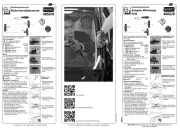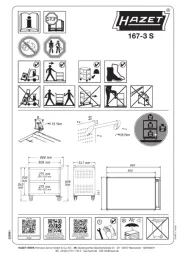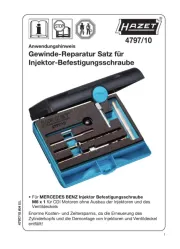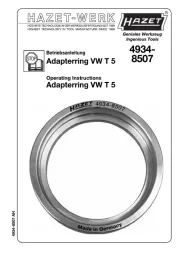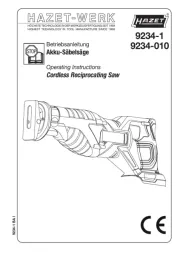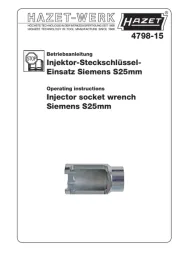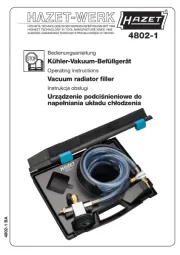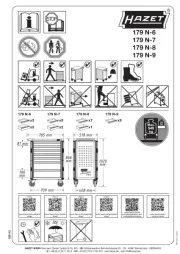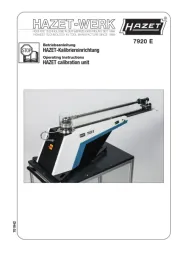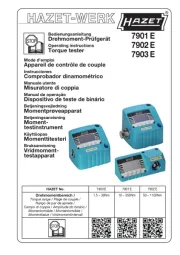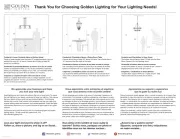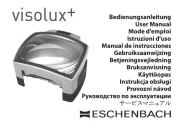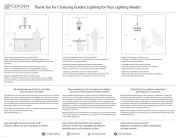
Informationen des Herstellers nach Verordnung (EU) 2016/425, An-
hang 2, Abschnitt 1.4. (Fundstelle im Amtsblatt der Europäischen Union)
Bitte sorgfältig vor Gebrauch durchlesen! Sie sind verpflichtet, diese In-
formationsbroschüre bei Weitergabe der persönlichen Schutzausrüstung
(PSA) beizufügen bzw. an den Empfänger auszuhändigen. Zu diesem
Zweck kann diese Broschüre uneingeschränkt vervielfältigt werden.
Artikel 1987 N-4 / PSA Kategorie 2
Lieferbare Größen / Ausführungen: 9
Bei diesen Handschuhen handelt es sich um Persönliche Schutz-
ausrüstung (PSA). Die CE-Kennzeichnung bescheinigt, dass das
Produkt den geltenden Anforderungen der Verordnung (EU) 2016/425
entspricht. Die komplette Konformitätserklärung erhalten Sie unter:
https://www.hazet.de/de/produkte/werkstattbedarf-arbeitsschutz/ar-
beitsschutz/23948/handschuhe?number=de_1987N-4
Markierungen auf den Handschuhen
Handelsmarke, Modell-Nr., Größe, CE-Zeichen, Piktogramme,
i-Zeichen, Fabriksymbol mit Herstellungsdatum Monat/Jahr
i-Zeichen: Hinweis auf die Informationen des Herstellers
09/2018 Herstellungsdatum Monat/Jahr
Erläuterung und Nummern der Normen, deren Anforderungen von
den Handschuhen erfüllt werden:
Fundstelle der Normen: Amtsblatt der Europäischen Union. Zu be-
ziehen bei Beuth Verlag GmbH, 10787 Berlin. www.beuth.de.
EN 420:2003+A1:2009 Schutzhandschuhe - Allgemeine Anforderun-
gen und Prüfverfahren für Handschuhe
EN 388:2016 Schutzhandschuhe gegen Mechanische Risiken
Schutzhandschuhe gegen mechanische Risiken müssen für minde-
stens eine der Eigenschaften (Abrieb-, Schnittfestigkeit, Weiterreiß- und
Durchstichkraft) mindestens Leistungsstufe 1 oder Leistungsstufe A für
die TDM-Schnittfestigkeitsprüfung nach EN ISO 13997:1999 erreichen.
Abriebfestigkeit: Die Anzahl der Umdrehungen, die nötig sind, um den
Testhandschuh durchzuscheuern.
Schnittfestigkeit: Die Anzahl der Testzyklen, bei denen bei konstanter
Geschwindigkeit der Prüfling durchschnitten ist.
Weiterreißkraft: Die Kraft, die nötig ist, den angeschnittenen Prüfling
Durchstichkraft: Die Kraft, die nötig ist, den Prüfling mittels einer stan-
dardisierten Prüfspitze zu durchstoßen. Je höher die
Ziffer, desto besser das Prüfergebnis. X bedeutet
„nicht geprüft“. P bedeutet „bestanden“
(Anzahl der Scheuertouren)
C = Weiterreißkraft (N) 10 25 50 75 -
D = Durchstichkraft (N) 20 60 100 150 -
E = Schnittfestigkeit nach
Prüfungskriterien Bewertung
A = Abriebfestigkeit 0 - 4
B = Schnittfestigkeit (Coupe Test) 0 - 5
C = Weiterreißkraft 0 - 4
D = Durchstichkraft 0 - 4
E = Schnittfestigkeit (TDM) nach
F = Stoßschutzprüfung nach
Durchstichkraft: Die Kraft, die nötig ist, den Prüfling mittels einer stan-
dardisierten Prüfspitze zu durchstoßen. Je höher die Ziffer, desto besser
das Prüfergebnis. X bedeutet „nicht geprüft“. P bedeutet „bestanden“
EN 13594:2015 Schutz gegen Stoß – Jeder Bereich, für den ein Schutz
gegen Stoß angegeben wird, ist zu prüfen. Aufgrund des Prüfverfah-
rens (Maße der Prüfprobe) kann der Fingerschutz gegen Stöße nicht
geprüft werden. Schutzhandschuhe gegen mechanische Risiken dür-
fen so konzipiert und ausgeführt werden, dass sie spezifische Aufprall-
dämpfung bieten (z.B. Aufprallschutz an den Fingerknöcheln, den Hand-
rücken, den Handinnenflächen). Derartige Handschuhe müssen den
Leistungen der Schutzklasse 1 nach EN 13594:2015 entsprechen. Bei
dem Auftreten von Abstumpfung während der Schnittfestigkeitsprüfung
(B) sind die Ergebnisse des Coupe-Tests nur als Hinweise zu verstehen,
wohingegen die TDM-Schnittfestigkeitsprüfung (E) Referenzergebnisse
bezüglich der Leistung liefert.
WARNUNG: Bei Handschuhen mit zwei oder mehreren Lagen gibt
die Gesamtklassifizierung nicht notwendigerweise die
Leistungsfähigkeit der äußersten Lage wieder.
WARNUNG: Handschuhe mit mechanischer Widerstandsfähigkeit,
die bezüglich der Weiterreißkraft (C) eine Leistungsstu-
fe von 1 oder höher erreichen und aufweisen, dürfen in
Fällen, bei denen ein Risiko besteht, sich in bewegten
Maschinenteilen zu verfangen, nicht getragen werden.
Nylon/Elastan Feinstrickhandschuhe, grau mit Strickbund und schwar-
zer Nitril-Mikro-Schaum-Beschichtung
Sehr guter Universalhandschuh gegen mechanische Risiken.
Modell-Nummer Handschuhgröße Entspricht
Prüfergebnisse EN 388:2016 Schutzhandschuhe
gegen Mechanische Risiken
Je höher die Ziffer, desto besser das Prüfergebnis. X bedeutet „nicht
geprüft“. P bedeutet „bestanden“.
Ergebnisse aus Proben der Handschuhinnenhand
CTC – CENTRE TECHNIQUE CUIR
69367 Lyon Cedex 07 - France
Verwendungszweck, Einsatzsatzgebiete und Risikobewertung
Diese Handschuhe entsprechen den angegebenen technischen Normen.
Es wird darauf hingewiesen, dass die tatsächlichen Anwendungsbedin-
gungen nicht simuliert werden können und es daher allein die Entschei-
dung des Benutzers ist, ob die Handschuhe für die geplante Anwen-
dung geeignet sind oder nicht. Der Hersteller ist bei unsachgemäßem
Gebrauch des Produkts nicht verantwortlich. Vor dem Gebrauch sollte
daher eine Bewertung des Restrisikos stattfinden, um festzustellen, ob
diese Handschuhe für den vorgesehenen Einsatz geeignet sind. Beach-
ten Sie die aufgedruckten Piktogramme und Leistungsstufen.
Vorsichtsmaßnahmen beim Gebrauch
• Diese Handschuhe nie in chemische Substanzen tauchen oder in
Kontakt mit chemischen Substanzen bringen.
• Verwenden Sie im Umgang mit Chemikalien ausschließlich Hand-
schuhe mit einem chemischen Piktogramm.
• Stellen Sie sicher, dass die ausgewählten Handschuhe widerstands-
fähig gegen die verwendeten Chemikalien sind.
• Verwenden Sie diese Handschuhe nicht zum Schutz vor gezackten
Kanten oder Schneiden bzw. offenem Feuer.
• Falls Handschuhe für Wärmeanwendungen erforderlich sind, stellen
Sie sicher, dass die Handschuhe den EN407 Anforderungen ent-
sprechen und Ihren Erfordernissen gemäß getestet wurden.
• Verwenden Sie die Handschuhe nicht in der Nähe beweglicher
• Vor dem Gebrauch die Handschuhe aufmerksam untersuchen, um
Fehler oder Mängel auszuschließen.
• Wenn die Handschuhe die Anforderungen der Durchstichkraft
nach EN 388:2016 erfüllen, kann jedoch nicht davon ausgegangen
werden, dass die Handschuhe auch Schutz gegen Perforieren mit
spitzen Objekten, wie z.B. Injektionsnadeln, bieten.
• Beschädigte, abgenutzte, schmutzige oder mit egal welcher
Substanz verschmierte (auch auf der Innenseite) Handschuhe nicht
mehr verwenden, da die Haut gereizt werden kann und es zu Haut-
entzündungen kommen kann. Sollte dies auftreten, ist ein Arzt oder
Dermatologe zu Rate zu ziehen.
Reinigung, Pflege und Desinfizierung
Sowohl neue als auch gebrauchte Handschuhe müssen, besonders
nachdem sie gereinigt worden sind, vor dem Tragen einer sorgfältigen
Überprüfung unterzogen werden, um sicherzustellen, dass keine Be-
schädigung vorliegt. Nach einer Reinigung weisen die Handschuhe mög-
licherweise nicht mehr die gleiche Leistung auf. Der Hersteller übernimmt
daher nach einer durchgeführten Reinigung keine Verantwortung mehr
für das Produkt. Handschuhe sollten niemals in verschmutztem Zustand
aufbewahrt werden, wenn sie wieder benutzt werden sollen. In diesem
Fall sollten die Handschuhe schon vor dem Ausziehen so gut wie mög-
lich gereinigt werden, vorausgesetzt, dass keine ernsthafte Gefahr be-
steht. Starke Verunreinigung muss als Erstes entfernt werden. Danach
können die Handschuhe mit einer schonenden Reinigungsmittellösung
gesäubert, mit klarem Wasser abgespült und am besten durch Luft-
bewegung getrocknet werden. Wenn die Verunreinigung nicht entfernt
werden kann oder eine mögliche Gefährdung darstellt, ist es ratsam,
die Handschuhe abwechselnd rechts und links vorsichtig abzustreifen.
Dabei die behandschuhte Hand so benutzen, dass die Handschuhe aus-
gezogen werden können, ohne dass die ungeschützten Hände mit der
Verunreinigung in Berührung kommen.
Kühl und trocken lagern, ohne direkten Einfall von Sonnenlicht, entfernt
von Zündquellen, möglichst in der Originalverpackung. Die Einsatzdauer
kann nicht genau angegeben werden und hängt von der Anwendung und
davon ab, ob der Benutzer sicherstellt, dass die Handschuhe nur für den
Zweck eingesetzt werden, für den sie auch bestimmt sind. Die Hand-
schuhe sind mit dem Produktionsdatum (Monat/Jahr) versehen.
Die benutzten Handschuhe können durch umweltschädigende oder ge-
fährliche Substanzen verunreinigt sein. Die Entsorgung der Handschuhe
ist in Übereinstimmung mit den örtlich anzuwendenden Rechtsnormen
Dieser Artikel wird paarweise in PE-Beuteln geliefert.
Dieses Produkt kann Latex aus Naturkautschuk enthalten, welchen zu
allergischen Reaktionen führen kann.
Allergien, hervorgerufen durch die fachgerechte Benutzung der Hand-
schuhe, sind bisher nicht bekannt. Sollte trotzdem eine allergische Re-
aktion auftreten, ist ein Arzt oder Dermatologe zu Rate zu ziehen.
Weitere Informationen durch:
HAZET - WERK - Hermann Zerver GmbH & Co. KG
Güldenwerther Bahnhofstr. 25-29 – D-42857 Remscheid
Die vollständige Konformitätserklärung sowie weitere technische
Informationen erhalten Sie unter https://www.hazet.de/de/produkte/
werkstattbedarf-arbeitsschutz/arbeitsschutz/23948/handschuhe?num-
Informações fornecidas pelo fabricante de acordo com o Regula-
mento (UE) 2016/425, Anexo 2, Secção 1.4. (Referência no Jornal Ofi-
Leia atentamente antes de usar! É obrigado a anexar esta brochura de
informação quando o equipamento de proteção individual (EPI) é trans-
mitido ou a entregá-la ao destinatário. Para este efeito, esta brochura
pode ser reproduzida sem restrições.
Artigo 1987 N-4/EPI categoria 2
Tamanhos disponíveis/Versões: 9
Declaração de conformidade
Estas luvas são equipamento de proteção individual (EPI). A mar-
cação CE certifica que o produto cumpre com os requisitos apli-
cáveis do Regulamento (UE) 2016/425. A Declaração de Conformidade
completa pode ser encontrada em: https://www.hazet.de/de/produkte/
werkstattbedarf-arbeitsschutz/arbeitsschutz/23948/handschuhe?num-
Marca, número de modelo, tamanho, marca CE, pictogramas,
marca i, símbolo de fábrica com data de fabrico mês/ano
marca i: Referência à informação do fabricante
09/2018 Data de fabrico mês/ano
Explicação e números das normas cujos requisitos são satisfeitos
Referência das normas: Jornal Oficial da União Europeia Disponível
em Beuth Verlag GmbH, 10787 Berlin. www.beuth.de.
EN 420:2003+A1:2009 Luvas de proteção - Requisitos gerais e mé-
todos de teste para luvas
EN 388:2016 Luvas de proteção contra riscos mecânicos
As luvas de proteção contra riscos mecânicos devem atingir pelo menos
o nível de desempenho 1 ou o nível de desempenho A para o teste de
resistência ao corte TDM, de acordo com a norma EN ISO 13997:1999,
para, pelo menos, uma das propriedades (resistência à abrasão, resis-
tência ao corte, resistência ao rasgão e resistência à perfuração).
Resistência à abrasão: O número de rotações necessárias para passar
Resistência ao corte: O número de ciclos de teste em que o objeto
de teste é avaliado em média a uma velocidade
Resistência ao rasgão: A força necessária para rasgar ainda mais o
objeto de teste de corte.
Resistência à perfuração: A força necessária para perfurar o objeto de
teste utilizando uma sonda de teste normal-
izada. Quanto maior for o número, melhor
será o resultado do teste. X significa "não
verificado". P significa "aprovado".
A = resistência à abrasão (número
de aplicações de fricção)
C = Resistência ao rasgão (N) 10 25 50 75 -
D = Resistência à perfuração (N) 20 60 100 150 -
Critérios de verificação Avaliação
A = resistência à abrasão 0 - 4
B = Resistência ao corte (Teste de corte)
C = Resistência ao rasgão 0 - 4
D = Resistência à perfuração 0 - 4
E = Resistência ao corte (TDM) confor-
F = Teste de proteção contra choques
Resistência à perfuração: A força necessária para perfurar o objeto de
teste utilizando uma sonda de teste normalizada. Quanto maior for o
número, melhor será o resultado do teste. X significa "não verificado".
EN 13594:2015 Proteção contra impacto - Qualquer área para a qual
seja especificada proteção contra impacto deve ser testada. Devido
ao procedimento de teste (dimensões da amostra de teste), a pro-
teção dos dedos contra impactos não pode ser testada. As luvas de
proteção contra riscos mecânicos podem ser concebidas e fabricadas
para proporcionar uma absorção de impacto específica (por exemplo,
proteção contra impactos nos nós dos dedos, nas costas da mão, nas
palmas das mãos). Tais luvas devem cumprir o desempenho da classe
de proteção 1 de acordo com a norma EN 13594:2015. Se ocorrer ent-
orpecimento durante o teste de resistência ao corte (B), os resultados
do teste do corte são apenas indicativos, enquanto que o teste de resis-
tência ao corte TDM (E) fornece resultados de referência relativamente
ATENÇÃO: Para luvas com duas ou mais camadas, a classificação
geral não reflete necessariamente o desempenho da ca-
ATENÇÃO: Luvas com resistência mecânica que atinjam e manten-
ham um nível de desempenho de 1 ou superior em ter-
mos de resistência ao rasgão (C) não devem ser usadas
nos casos em que exista o risco de ficarem presas em
partes móveis da máquina.
Luvas de malha fina de nylon/elastano, cinzentas com punho de malha e
revestimento de microespuma de nitrilo preto
Uma luva universal muito boa contra riscos mecânicos.
Número do modelo Tamanho de luvas Corresponde
Resultados da verificação EN 388:2016
Luvas de proteção contra riscos mecânicos
Quanto maior for o número, melhor será o resultado do teste. X signifi-
ca "não verificado". P significa "aprovado".
Resultados de amostras de palmas de luvas
Todas as verificações por:
CTC – CENTRE TECHNIQUE CUIR
69367 Lyon Cedex 07 - França
Utilização pretendida, áreas de aplicação e avaliação de risco
Estas luvas estão em conformidade com as normas técnicas especifi-
cadas. É de notar que as condições reais de utilização não podem ser
simuladas e, portanto, cabe apenas ao utilizador decidir se as luvas
são ou não adequadas para a aplicação pretendida. O fabricante não
é responsável se o produto for utilizado de forma imprópria. Antes da
utilização, deve ser realizada uma avaliação de risco residual para deter-
minar se estas luvas são adequadas para o uso pretendido. Observe os
pictogramas impressos e os níveis de desempenho.
• Nunca mergulhe estas luvas em substâncias químicas, nem as
coloque em contacto com substâncias químicas.
• Ao manusear produtos químicos, use apenas luvas com pictograma
• Certifique-se de que as luvas que escolhe são resistentes aos
produtos químicos utilizados.
• Não utilize estas luvas para proteger contra arestas recortadas ou
• Se forem necessárias luvas para aplicações térmicas, certifique-se
de que as luvas cumprem os requisitos da norma EN407 e foram
testadas de acordo com as suas necessidades.
• Não utilize as luvas perto de peças de máquinas em movimento.
• Inspecione cuidadosamente as luvas antes da sua utilização para
descartar falhas ou defeitos.
• No entanto, se as luvas cumprirem os requisitos de resistência à
perfuração de acordo com a norma EN 388:2016, não se pode as-
sumir que as luvas também fornecem proteção contra a perfuração
por objetos cortantes, tais como agulhas hipodérmicas.
• Não utilize luvas danificadas, gastas, sujas ou manchadas com
qualquer substância (mesmo no interior), pois a pele pode ficar
irritada e pode ocorrer inflamação cutânea. Se isto ocorrer, deverá
consultar um médico ou dermatologista.
Limpeza, conservação e desinfeção
Tanto as luvas novas, como as usadas, especialmente depois de terem
sido limpas, devem ser cuidadosamente inspecionadas antes da sua uti-
lização, de forma a garantir que não há danos. As luvas podem não ter
o mesmo desempenho após a limpeza. Deste modo, o fabricante deixa
de aceitar a responsabilidade pelo produto após a limpeza ter sido efe-
tuada. As luvas nunca devem ser armazenadas num estado sujo quando
se destinam a ser usadas novamente. Neste caso, as luvas devem ser
limpas o mais possível antes de as tirar, desde que não haja perigo gra-
ve. A sujidade forte deve ser removida primeiro. Depois, as luvas podem
ser limpas com uma solução detergente suave, lavadas com água limpa
e, de preferência, secas ao ar. Se não for possível remover a sujidade ou
for um perigo potencial, é aconselhável limpar cuidadosamente as luvas
alternadamente do lado direito e esquerdo. Utilize a mão com luva de
forma a que as luvas possam ser retiradas sem que as mãos desprote-
gidas entrem em contacto com a sujidade.
Armazenamento e envelhecimento
Armazene num local fresco e seco, sem luz solar direta, longe de fontes
de ignição, se possível na embalagem original. A duração da utilização
não pode ser especificada exatamente e depende da aplicação e de o
utilizador garantir que as luvas são utilizadas apenas para o fim a que se
destinam. As luvas são marcadas com a data de produção (mês/ano).
As luvas usadas podem estar contaminadas por substâncias nocivas ou
perigosas para o ambiente. As luvas devem ser descartadas de acordo
com as normas legais aplicáveis localmente.
Este artigo é fornecido em pares em sacos de polietileno.
Este produto pode conter látex de borracha natural, o que pode causar
Até ao momento, não são conhecidas alergias causadas pelo uso pro-
fissional das luvas. Ainda assim, se ocorrer uma reação alérgica, deverá
consultar um médico ou dermatologista.
Mais informações através de:
HAZET-WERK – Hermann Zerver GmbH & Co. KG
Güldenwerther Bahnhofstr. 25-29 – D-42857 Remscheid
A Declaração de Conformidade completa, bem como outras infor-
mações técnicas, podem ser encontradas em: https://www.hazet.de/
de/produkte/werkstattbedarf-arbeitsschutz/arbeitsschutz/23948/hand-
Informacje dla użytkownika
Informacje producenta zgodnie z rozporządzeniem (UE) 2016/425,
załącznik 2, rozdział 1.4. (odniesienie w Dzienniku Urzędowym Unii
Przeczytać dokładnie przed użyciem! W przypadku przekazania
środka ochrony indywidualnej (ŚOI) należy załączyć niniejszą broszurę
informacyjną lub wręczyć ją odbiorcy środka. W tym celu można
powielać niniejszą broszurę bez ograniczeń.
Artykuł 1987 N-4 / kategoria ŚOI 2
Dostępne rozmiary / wersje: 9
Opisane tu rękawice są zaliczane do środków ochrony indywidu-
alnej (ŚOI). Oznaczenie CE potwierdza, że produkt spełnia
obowiązujące wymogi rozporządzenia (UE) 2016/425. Kompletna dekla-
racja zgodności jest dostępna pod następującym adresem:
https://www.hazet.de/de/produkte/werkstattbedarf-arbeitsschutz/ar-
beitsschutz/23948/handschuhe?number=de_1987N-4
Marka, nr modelu, rozmiar, oznaczenie CE, piktogramy,
oznaczenie i, symbol fabryczny z datą produkcji miesiąc/rok
Oznaczenie i: oznacza informacje producenta
09/2018 data produkcji miesiąc/rok
Objaśnienia i numery norm, których wymogi muszą być spełnione
Odniesienie do norm: Dziennik Urzędowy Unii Europejskiej. Do
nabycia w wydawnictwie Beuth Verlag GmbH, 10787 Berlin. www.
EN 420:2003+A1:2009 Rękawice ochronne - Wymagania ogólne i
metody badań dotyczące rękawic
EN 388:2016 Rękawice chroniące przed zagrożeniami mechanic-
Rękawice chroniące przed zagrożeniami mechanicznymi muszą
posiadać poziom skuteczności 1 dla co najmniej jednej właściwości
(odporność na przetarcie, przecięcie, rozerwanie, przebicie) lub poziom
skuteczności A w zakresie odporności na przecięcie TDM zgodnie z
Odporność na przetarcie: Liczba obrotów potrzebnych do przetarcia
Odporność na przecięcie: Liczba cykli, po których przy stałej prędkości
badany produkt zostanie przecięty.
Odporność na rozerwanie: Siła potrzebna do dalszego rozerwania
naciętego badanego produktu.
Odporność na przebicie: Siła potrzebna do przebicia badanego pro-
duktu za pomocą standaryzowanego ostrza.
Im wyższa cyfra, tym lepszy wynik testu. X
oznacza „nie badano“. P oznacza „test za-
A = odporność na przetarcie
B = odporność na przecięcie
C = odporność na rozerwanie (N) 10 25 50 75 -
D = odporność na przebicie (N) 20 60 100 150 -
A = odporność na przetarcie 0 - 4
B = odporność na przecięcie (Coup Test)
C = odporność na rozerwanie 0 - 4
D = odporność na przebicie 0 - 4
E = odporność na przecięcie (TDM) wg
F = Odporność na uderzenie wg normy
Odporność na przebicie: Siła potrzebna do przekłucia badanego pro-
duktu za pomocą standaryzowanego ostrza. Im wyższa cyfra, tym lepszy
wynik testu. X oznacza „nie badano“. P oznacza „test zaliczony“
EN 13594:2015 Ochrona przed uderzeniem – Należy poddać testom
każdy obszar, dla którego zadeklarowana jest ochrona przed uderze-
niem. Ze względu na metodę badania (wymiary badanej próbki) nie
jest możliwe zbadanie ochrony palców przed uderzeniem. Rękawice
chroniące przed zagrożeniami mechanicznymi mogą być tak zaprojekt-
owane i wykonane, że oferują specyficzne tłumienie przy uderzeniu (np.
ochrona przed uderzeniem kostek palców, grzbietu dłoni, wewnętrznych
powierzchni dłoni). Takie rękawice muszą spełniać wymogi klasy ochro-
ny 1 wg normy EN 13594:2015. W przypadku wystąpienia stępienia pod-
czas badania odporności na przecięcie (B) wyniki testu Coup Test należy
traktować jedynie jako wskazówki. Natomiast badanie odporności na
przecięcie TDM (E) daje wyniki referencyjne dotyczące skuteczności.
OSTRZEŻENIE: W przypadku rękawic o dwóch lub więcej warst-
wach klasyfikacja ogólna nie musi koniecznie
określać skuteczności wierzchniej warstwy.
OSTRZEŻENIE: Rękawice odporne na działanie czynników mecha-
nicznych, które w zakresie odporności na rozerwa-
nie (C) osiągnęły lub wykazują poziom skuteczności
1 lub wyższy, nie mogą być stosowane w przypad-
kach, gdy zachodzi ryzyko ich pochwycenia przez
Dzianinowe rękawice z nylonu/elastanu, szare, ze ściągaczem i czarną
powłoką z mikropianki nitrylowej
Bardzo dobre rękawice uniwersalne chroniące przed zagrożeniami me-
Numer modelu Rozmiar rękawic Odpowiada
